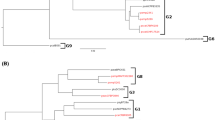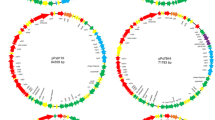Abstract.
Pseudomonas syringae are differentiated into approximately 50 pathovars with different plant pathogenicities and host specificities. To understand its pathogenicity differentiation and the evolutionary mechanisms of pathogenicity-related genes, phylogenetic analyses were conducted using 56 strains belonging to 19 pathovars. gyrB and rpoD were adopted as the index genes to determine the course of bacterial genome evolution, and hrpL and hrpS were selected as the representatives of the pathogenicity-related genes located on the genome (chromosome). Based on these data, NJ, MP, and ML phylogenetic trees were constructed, and thus 3 trees for each gene and 12 gene trees in total were obtained, all of which showed three distinct monophyletic groups: Groups 1, 2 and 3. The observation that the same set of OTUs constitute each group in all four genes suggests that these genes had not experienced any intergroup horizontal gene transfer within P. syringae but have been stable on and evolved along with the P. syringae genome. These four index genes were then compared with another pathogenicity-related gene, argK (the phaseolotoxin-resistant ornithine carbamoyltransferase gene, which exists within the argK–tox gene cluster). All 13 strains of pv. phaseolicola and pv. actinidiae used had been confirmed to produce phaseolotoxin and to have argK, whose sequences were completely identical, without a single synonymous substitution among the strains used (Sawada et al. 1997a). On the other hand, argK were not present on the genomes of the other 43 strains used other than pv. actinidiae and pv. phaseolicola. Thus, the productivity of phaseolotoxin and the possession of the argK gene were shown at only two points on the phylogenetic tree: Group 1 (pv. actinidiae) and Group 3 (pv. phaseolicola). A t test between these two pathovars for the synonymous distances of argK and the tandemly combined sequence of the four index genes showed a high significance, suggesting that the argK gene (or argK–tox gene cluster) experienced horizontal gene transfer and expanded its distribution over two pathovars after the pathovars had separated, thus showing a base substitution pattern extremely different from that of the noncluster region of the genome.
Similar content being viewed by others
Author information
Authors and Affiliations
Additional information
Received: 18 January 1999 / Accepted: 25 May 1999
Rights and permissions
About this article
Cite this article
Sawada, H., Suzuki, F., Matsuda, I. et al. Phylogenetic Analysis of Pseudomonas syringae Pathovars Suggests the Horizontal Gene Transfer of argK and the Evolutionary Stability of hrp Gene Cluster. J Mol Evol 49, 627–644 (1999). https://doi.org/10.1007/PL00006584
Issue Date:
DOI: https://doi.org/10.1007/PL00006584




